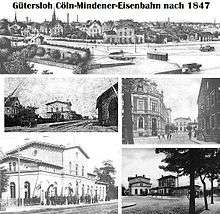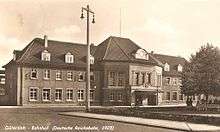Gütersloh Hauptbahnhof
Gütersloh Hauptbahnhof | |
|---|---|
| Through station | |
 Entrance to the station hall | |
| Location |
Gütersloh, North Rhine-Westphalia Germany |
| Coordinates | 51°54′25″N 8°23′5″E / 51.90694°N 8.38472°ECoordinates: 51°54′25″N 8°23′5″E / 51.90694°N 8.38472°E |
| Line(s) | |
| Platforms | 4 |
| Other information | |
| Station code | 2438 [1] |
| DS100 code | EGLO [2] |
| Category | 4 [1] |
| Website | www.bahnhof.de |
| History | |
| Opened | 1847 [3] |
Gütersloh Hauptbahnhof is the main railway station in Gütersloh in the German state of North Rhine-Westphalia. It is on the electrified, four-track main line from the Ruhr to Hanover, opened in 1847 as part of the trunk line of the former Cologne-Minden Railway Company. Services of the Warendorf Railway also run from Münster via Rheda-Wiedenbrück and the Hamm–Minden line to Gütersloh.
Gütersloh Hauptbahnhof (Hbf) is classified by Deutsche Bahn as a category 4 station.[1] In the station building there is a tourist bureau, where tickets can be purchased. There is also has a restaurant/bistro, a bakery, a mini-supermarket and a station bookshop.
History




Gütersloh‘s original station building was built between 1845 and 1847 by the Cologne-Minden Railway Company[3] at the end of today's Kökerstraße. Two side wings were added in 1876/77 and the Königliche Eisenbahndirektion Hannover (railway division of the Prussian state railways of Hanover) built another extension at the turn of the century. After the neo-classical entrance building was demolished for the quadruplication of the Hamm–Minden line, Deutsche Reichsbahn-Gesellschaft (DRG) opened a new monumental station building at its present location on the street then called Queckwinkel on 21 December 1925. The extensive rebuilding of the extensive rail facilities, which replaced all the level crossings with underpasses, was completed in 1930 with the opening of the new freight yard beyond the freight tracks on Langer Weg. The ticket hall and the south wing (with the ticket office, express freight and baggage handling facilities) were damaged by air raids on 14 March 1945 and blown up by American troops in April 1945. For about six years it was necessary to buy tickets and to despatch baggage a temporarily constructed shed on the station forecourt. Deutsche Bundesbahn (DB) incorporated the north wing, which was still-standing and included a station restaurant and waiting room, in the reconstruction. The new south wing was built on the foundations of the previous building as an extended building and reinaugurated on 3 October 1951. With the completion of the new entrance hall in a simpler form in 1953, today's station had taken form adjoining the eastern end of inner city.[4][5]
The first test train, hauled by electric locomotive E10 438, ran on 25 September 1968, and official services commenced in Gütersloh Hbf with a special train hauled by 112498-1 on 29 September 1968. Since that day, the section between Hamm and Wunstorf has been electrified and the important link between the Ruhr and Hanover has been open for continuous electrical operations.
Since 1973, Gütersloh Hbf has always served as a starting point for testing high-speed train operations by the Bundesbahn Central Offices (BZA) in Minden. In September 1973 an electric locomotive of class 103 reached a speed of 252.9 km/h on a test section between Gütersloh and Neubeckum. The 58.0 km-long section between Brackwede and Hamm became one of the first lines in Germany to be upgraded for scheduled services at 200 km/h in 1979 and, since then, the two platforms on the main tracks 2 and 3 runs are regularly passed at the 200 km/h maximum speed. On 26 November 1985, at 11:29, an InterCityExperimental train fully occupied with passengers on the line between Gutersloh and Hamm reached a speed of 317 km/h. This was a new German record for rail vehicles and a world record for rail vehicles using three-phase power.[6][7]
The display boards on the platforms had been defective since December 2005 and were repaired by Deutsche Bahn in October 2008. Since February 2010, extensive refurbishment has been carried out at the station. Deutsche Bahn was funded by about €3 million from an economic stimulus package. The work was initially scheduled to be completed by the end of March 2011. All four platform edges of the two island platforms have been raised and adapted for the visually impaired. Comprehensive lighting and new equipment was also installed at the station. In addition, passenger lifts were put into operation on the platforms on 23 December 2011.[8] The temporary lifts that were previously used have now been removed.
The Zweckverband Verkehrsverbund OWL (Ostwestfalen-Lippe transport association) is seeking the resumption of passenger services on the Teutoburg Forest Railway (Teutoburger Wald-Eisenbahn) line to Harsewinkel and Verl in December 2016. If this is realized trains would run via a new rail connection to the TWE and stop on platform 1.[9]
Rail services
In long-distance traffic, the station is served every two hours by an Intercity service on line IC 55 between Cologne and Leipzig. On Fridays and Sundays an additional intercity services runs every two hours on the line IC 32 between Stuttgart or Karlsruhe and Berlin Südkreuz. During early or late hours some Intercity-Express services also stop in Gütersloh.
| Line | Route | Frequency | |
|---|---|---|---|
| ICE 10 | Berlin Ostbf – Hannover – Gütersloh – Hamm | Dortmund – Duisburg – Düsseldorf (– Cologne/Bonn Airport) | Hourly (uncoupled in Hamm) |
| Wuppertal – Cologne (– Bonn) | |||
| IC 32 | Berlin Südkreuz – Hannover – Gütersloh – Hamm – Dortmund – Duisburg – Düsseldorf (– Mönchengladbach – Aachen – Düren) – Cologne | Every 2 hours (Fri / Sun) | |
| IC 55 | Leipzig – Magdeburg – Gütersloh – Wuppertal – Cologne (one train pair:– Bonn – Mainz – Mannheim – Stuttgart – Ulm – Kempten (Algäu) – Oberstdorf ) | Every 2 hours | |
| Preceding station | Deutsche Bahn | Following station | ||
|---|---|---|---|---|
towards Cologne Hbf | IC 55 | towards Leipzig Hbf |
There is a regional service at 30-minute intervals between Gütersloh and Hamm. There have been three services per hour to Bielefeld since December 2006. Gütersloh Hbf is served by the following lines:[10]
| Line | Name | Route | Operator |
|---|---|---|---|
| RE 6 | Westfalen-Express | Minden (Westf) – Bielefeld – Gütersloh – Hamm (Westf) – Dortmund – Bochum – Essen – Duisburg – Düsseldorf | DB Regio NRW |
| RB 67 | Der Warendorfer | Bielefeld – Gütersloh – Warendorf – Münster (Westf) | Eurobahn |
| RB 69 | Ems-Börde-Bahn | Bielefeld – Gütersloh – Hamm (Westf) – Münster (Westf) | Eurobahn |
| Preceding station | Deutsche Bahn | Following station | ||
|---|---|---|---|---|
toward Düsseldorf Hbf | RE 6 Westfalen-Express | toward Minden Hbf |
||
| Preceding station | eurobahn | Following station | ||
toward Münster Hbf | RB 67 Der Warendorfer | Isselhorst-Avenwedde toward Bielefeld Hbf |
||
toward Münster Hbf | RB 69 Ems-Börde-Bahn | Isselhorst-Avenwedde toward Bielefeld Hbf |
Fares
The station is covered by Der Sechser (“the six”) fares of the Zweckverband Verkehrsverbund OWL (Ostwestfalen-Lippe transport association). In addition, transitional fares of the Münsterland-Tarif (Verkehrsgemeinschaft Münsterland, Munsterland Transport Community) apply to Warendorf or Ahlen and the whole area is covered by the state-wide NRW-tariff fares.
Station connections
Directly opposite the entrance to the station is a central bus station. From here, the Gütersloh urban area is served by the star-shaped city bus network of Stadtwerke Gütersloh. There are also regional bus services to neighbouring towns.
At walking distance beyond the main post office and Friedrich-Ebert-Straße is the Gütersloh Nord station of the Teutoburg Forest Railway (Teutoburger Wald-Eisenbahn, TWE), which formerly ran passenger services towards Hövelhof and Ibbenbüren. This terminus is still used occasionally for museum services operating as the Teuto-Express.
Notes
- 1 2 3 "Stationspreisliste 2016" [Station price list 2016] (PDF) (in German). DB Station&Service. 1 December 2015. Retrieved 24 January 2016.
- ↑ Eisenbahnatlas Deutschland (German railway atlas) (2009/2010 ed.). Schweers + Wall. 2009. ISBN 978-3-89494-139-0.
- 1 2 "Gütersloh station operations". NRW Rail Archive (in German). André Joost. Retrieved 31 December 2013.
- ↑ Stephan Grimm (31 July 2001). "Gütersloh in alten Bildern - Gütersloher Bahnhof 1945". Neue Westfälische (in German).
- ↑ "Das Warten hat ein Ende". Neue Westfälische (in German). 4 November 2009. Retrieved 31 December 2013.
- ↑ "ICE erreicht 317 km/h (ICE reaches 317 km/h)". Eisenbahntechnische Rundschau (in German) 34 (12): 846. May 1985.
- ↑ "ICE ZUG DER ZUKUNFT (ICE train of the future)". Eisenbahntechnische Rundschau (in German) 34 (12): 908. May 1985.
- ↑ "Aufzüge im Bahnhof ein Weihnachtsbonbon". Die Glocke (in German). 1 December 2011. Retrieved 1 January 2014.
- ↑ "Neue Konkurrenz für die TWE - Gutachten soll im Dreikampf um die Wiederaufnahme des Personennahverkehrs die Weichen stellen". Neue Westfälische (in German). 27 April 2013. Retrieved 1 January 2014.
- ↑ "Gütersloh Hbf". NRW Rail Archive (in German). André Joost. Retrieved 31 December 2013.
References
| Wikimedia Commons has media related to Gütersloh Hauptbahnhof. |
- Werner Menninghaus (1983). Die Cöln-Mindener Eisenbahn in Ostwestfalen – Vom Planzug 1 bis zum Intercity (in German). Verlag Uhle & Kleimann. ISBN 3-922657-27-3.
- Anette Gantenberg, Milena Karabaic, ed. (1997). Vom Rhein zur Weser - mit der Köln-Mindener Eisenbahn von Deutz nach Minden (in German). Klartext Verlag. ISBN 3-88474-580-8.